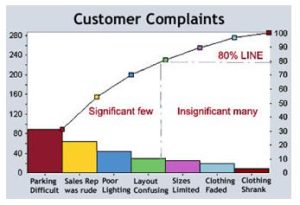How to eat an elephant?
Have you ever confronted a situation doing hard work the whole day and at the end you realize that most of the time had been given by you and your team to the Non Value Added things!
Buy The Master Book for Lean Six Sigma Green Belt Certification CSSGB
One of the important aspects of the leadership in today’s competitive world is Prioritization. It helps to save time and money as you will be able to focus on what is important at the expense of lower value activities. Prioritizing skills are your ability to see what tasks are more important at each moment and give those tasks more of your attention, energy, and time.
We all have so much on hand to do and really speaking so much time to finish the things up. But we lack the skill to manage our work with the time. We mostly forget to take up the important things first and less significant work later. Instead, we do completely opposite to this. This is human nature as we all do the same thing in our day to day lives.
This issue is pertinent not only at an individual level, but even at organizational level. Organizations focus on the wrong reasons or causes and waste a lot of effort to solve a problem or improve their business.
How to improve upon it?
Lean Six Sigma teaches a very useful technique of prioritization to overcome this problem which is a mother of our all the other problems.
Pareto Analysis is based on 80/20 rule which says that our 20% efforts (out of the whole 100%) will give 80% of the benefits. This can be interpreted in many different ways like, for sales people 80% of the orders will come from the 20% of the customers, for team managers 20% people of the whole team shall give 80% of the work or results. Here, we should keep in mind that this doesn’t mean that the rest 20% is not important at all but can be said as less significant.
To generalize, 80% of the problem is caused by 20% of the reasons!
Thus using the Pareto principle, we can derive maximum impact with minimum effort and within short time span, if we focus on the right factors. Simple it is, right?
Before understanding the benefits of Pareto Analysis there are certain facts to be known about it. They are as under:
 Our Online Lean Six Sigma Green Belt Certification course teaches you step by step procedure to construct a pareto chart, different pareto variants and how to interpret them. More importantly it covers when and when not to apply pareto principle.
Benefits of Pareto Analysis:
Our Online Lean Six Sigma Green Belt Certification course teaches you step by step procedure to construct a pareto chart, different pareto variants and how to interpret them. More importantly it covers when and when not to apply pareto principle.
Benefits of Pareto Analysis:
- This principle was developed in the year 1896 and is named after Vilfredo Pareto who was an Italian engineer, sociologist, economist, political scientist, and philosopher.
- Pareto derived this concept by his work and experience and observed that 80% of the wealth in Italy belonged to 20% of the people.
- In the year 1941, Dr, Joseph Juran who was an evangelist of quality and quality management as he was an engineer and a management consultant cam across the concept of Pareto Principle. He then started applying the principle in the quality and derived a phrase through experience that is “there are vital few and useful many”.
- The Pareto Principle can be implemented in many different aspects such as in science, management, business, in software, in sports, occupational health and safety, financial service industry, and implementing projects which says that put 80% of your time in 20% of your project which will save a lot of your time and energy.
- Pareto principle can be graphically represented by Pareto Chart that contains bothbars and a line graph, where individual values are represented in descending order by bars, and the cumulative total is represented by the line.
 Our Online Lean Six Sigma Green Belt Certification course teaches you step by step procedure to construct a pareto chart, different pareto variants and how to interpret them. More importantly it covers when and when not to apply pareto principle.
Benefits of Pareto Analysis:
Our Online Lean Six Sigma Green Belt Certification course teaches you step by step procedure to construct a pareto chart, different pareto variants and how to interpret them. More importantly it covers when and when not to apply pareto principle.
Benefits of Pareto Analysis:
- Improved Decision Making: With a focus on resolving problems, the procedures and processes required to make the changes should be documented during a Pareto analysis. This documentation will enable better preparation and improvements in decision making for future changes.
- Increased Efficiency: Once the changes or problems are listed, they are ranked in order from the biggest to the least severe. The problems ranked highest in severity should become the main focus for problem resolution or improvement. Focusing on causes and problem resolution contributes to organizational efficiency.
- Enhanced Problem Solving Technique: Members of a group can conduct a Pareto analysis together. Arriving at a group consensus about the issues that require change fosters organizational learning and increases group cohesiveness. Lean Six Sigma Green Belt Certification course shall help the individuals of the company learn many tools along with Pareto Analysis which shall also help him or her to boost their careers.
- Saves Time and Money: Doing right things at the right time with right people and at the right place is naturally going to save time and money and this has to be calculated by multiplying the time with the number of individuals involved in the process.

